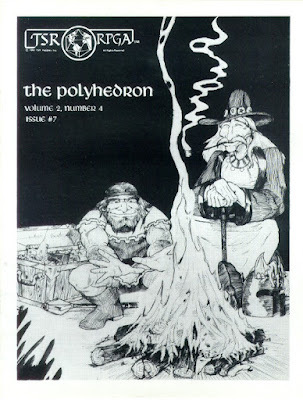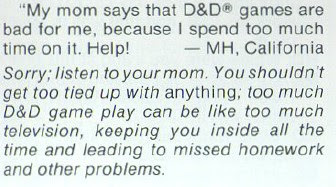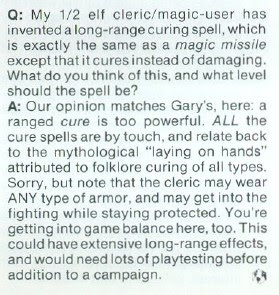Polyhedron: Issue #7
 Issue # 7 of Polyhedron (August 1982) once again features a cover artist – Scott Roberts – with whom I am unfamiliar. I find this fascinating, as it suggests that the staff of the 'zine wanted to cultivate a unique look for the periodical, one that was distinct from that of Dragon, even though both were published by TSR. True or not, this trend lessened somewhat as Polyhedron's run continued, as we'll see in future posts in this series.
Issue # 7 of Polyhedron (August 1982) once again features a cover artist – Scott Roberts – with whom I am unfamiliar. I find this fascinating, as it suggests that the staff of the 'zine wanted to cultivate a unique look for the periodical, one that was distinct from that of Dragon, even though both were published by TSR. True or not, this trend lessened somewhat as Polyhedron's run continued, as we'll see in future posts in this series. The issue begins with Frank Mentzer's last(?) "Where I'm Coming From," in which he briefly recounts the founding of the RPGA and the role he and others played in that. Then, he announces that "it's time for me to move on," as he will soon be "very, very busy working with Gary." He explains that he will "essentially ... be #2 right after Gary when it comes to D&D® rules and AD&D™ games, and so forth." This is obviously a reference to his oversight of the revision of Dungeons & Dragons game, as well as his assistance in getting things like The Temple of Elemental Evil completed, both of which earned Mentzer a lasting place in the history of the hobby.
The letters page includes the following:
 This letter hits home, because I remember well the first few years after I discovered D&D and other RPGs. They were most definitely obsessions for me – not to the extent that they affected my schoolwork and other responsibilities, but I certainly devoted a lot of time to playing and preparing to play them.
This letter hits home, because I remember well the first few years after I discovered D&D and other RPGs. They were most definitely obsessions for me – not to the extent that they affected my schoolwork and other responsibilities, but I certainly devoted a lot of time to playing and preparing to play them. "Dispel Confusion" contains a number of interesting questions and answers this issue. For example, one reader asks about the level at which a ranger casts druid and magic-user spells in AD&D. The answer is that, at the time a ranger gains access to a new type of spellcasting, he casts those spells as if he were 1st level in the appropriate class. Thus, a ranger gains druid spells at 8th level in his class but casts those spells as if he were a 1st-level druid. The same is true of magic-user spells, which a ranger gains at 9th level. I believe I already knew this, but it was fascinating to be reminded of it. Additionally, there's this question and answer:
 I have no strong feelings about this matter one way or the other, but I do think the reasoning here is worthy of note. Also notable is the way that Mentzer, who provided this issue's answers, mentions that he agrees with "Gary" on this point – another example of the Cult of Gygax that was popularized in the pages of TSR periodicals.
I have no strong feelings about this matter one way or the other, but I do think the reasoning here is worthy of note. Also notable is the way that Mentzer, who provided this issue's answers, mentions that he agrees with "Gary" on this point – another example of the Cult of Gygax that was popularized in the pages of TSR periodicals."RPGA Interview with Mike Carr" is exactly what you'd expect: an extensive interview with Mike Carr, who was at this point Executive Vice President of TSR's Manufacturing Division. From my perspective, the interview is quite good, focusing a lot on the early days of both the hobby and TSR. It's also very clear, as if there were any doubt, that Dawn Patrol means a lot to Carr, since he mentions it often in his answers. "Spelling Bee" looks at clerical and druid spells, providing some thoughts on their use in play. Of interest is the following note about know alignment: "Often cast at the beginning of an adventure, it's aimed at 1, 2, or 3 creatures, all of whom (except the Lawful Goods) should retaliate by disrupting the casting, leaving the area quickly, or some other equally rude action."
Gary Gygax offers a very short piece entitled "Notes from the DM," in which he holds forth on the matter of AD&D's one-minute combat round and "detailed combat." All of this old hat to those of us who've seen Gygax discuss this in other places. However, the fact that he needs to keep trying to justify it goes a long way, I think, to explain why it would eventually be abandoned in contemporary versions of the game (and, it should be noted, in Dungeons & Dragons, including the edition that Mentzer himself would develop).
"Campaign Clues" by Corey Koebernick, husband of Jean Wells, offers advice to Top Secret referees (or Administrators) on starting espionage campaigns. Meanwhile, Bill Fawcett's "Ranch Encounters" is a collection of random encounters for use with Boot Hill. One of the upsides of Polyhedron's narrow focus on TSR RPGs is that each issue is likely to contain articles devoted to some of these "lesser" games that my friends and I played. That's something that mattered a lot to me at the time, since Dragon tended not to include many articles of this sort, at least not when I was a regular reader (the day of the Ares Section being a significant exception).
"Notes for the Dungeon Master" takes a look at higher-level characters. At the start of the article, Frank Mentzer, the author, mentions that "looking at the data we've received from hundreds of DMs worldwide, it seems the average advancement of a character is about 2–3 levels per year." That jibes with my own experience of playing AD&D around this time, though I also recall a few outliers who achieved higher levels, mostly due to being played very often (and perhaps a little greater generosity of XP on my part).
This issue marks the first appearance of the RPGA Gift Catalog about which I've written before. I still get a kick out of looking at it even now, because it's such a wonderful artifact from the days of D&D's faddishness. "Convention Wrapup" briefly reports all the happenings at various conventions across the USA during the previous months. As one would expect, there's much emphasis on RPGA events, including the winners of tournaments, who are listed by name. I always keep an eye out, to see if I recognize any notable individuals among the winners. Finally, there's Roger Raupp's comic, "Nor." Sadly, the comic continues to plod along without any obvious direction and there's still no follow-up to the crashed spacecraft from its very first installment.
Oh well, there's always next issue, the very first one I ever owned.
Published on August 29, 2023 10:47
No comments have been added yet.
James Maliszewski's Blog
- James Maliszewski's profile
- 3 followers
James Maliszewski isn't a Goodreads Author
(yet),
but they
do have a blog,
so here are some recent posts imported from
their feed.



